By Miva | June 27, 2013

See why top ecommerce brands use Miva’s no-code platform to run
multiple stores, manage massive catalogs, and grow their revenue.
We all know that content marketing is extremely important for search engine rankings as well as the entire marketing strategy. However, it can be difficult for store owners to keep up with the demands for content curation and the turnover necessary for it to be effective. This is why many businesses have opted to have their customers generate their content for them.
According to Worldometers.info, over 2.5 million blog posts are being published each day and every second 2,200 tweets are published. The need for generating valuable and continuously fresh content is more present than ever before. Creating unique, quality content is vitally important, and yet it is also extremely time-consuming. This is where User Generated Content (UGC) comes in handy.
UGC allows you to distribute a need in your business (in this case, generating content) to a group of people who have the time and resources to satisfy that need. You could think of UGC as distributed problem solving. You have a problem, and your customers have a solution. With the rise of social media and sharing apps, it is easier than ever for store owners to accumulate content from customers. User Generated Content drives engagement among consumers, which can lead to increased revenue and brand-advocates for life. In this blog series, we will guide you through the different options of User Generated Content, the precautions you should take, and how to plan for your campaign.
User generated content can include anything from product reviews to customers creating your next product. Because UGC can come in so many different forms, it is important to pick the right one for your business. In Part 1, we review the most common User Generated Content strategies and the ecommerce stores that have successfully implemented those strategies.
Consumer goods companies that sell a product or a range of products can use consumer-generated product reviews to improve SEO and increase sales.
Here are just a few of the many statistics that validate the benefits of user-generated product reviews:
Allow customers to create a profile. Offering customers the opportunity to post a profile will help encourage fans to show off their expertise on your products. Not only will this opportunity encourage these fans to post more reviews about your products, it will also make the reviews more valuable to other customers by offering camaraderie through an online community. Additionally, the highest converting SEO traffic comes from traffic which lands directly on the product page.
There are plenty of benefits that come along with shopper-generated product reviews that go beyond increased conversions. Some of these include improved search engine ranking, fresh and relevant content, insight into ways you can improve your products, as well as an understanding of how your customers use your products.
Forrester reports that 80% of reviews are positive (2008). It can be tempting to delete the negative comments, but it is important for you to be transparent to your customers. Unless it is a completely false review, you should keep it and respond to them with a solution. Focus on having balanced reviews, and it will actually help you sell more. Have a plan. Before you launch a ratings and reviews strategy, think about how you’ll address negative comments.
Even bad reviews can be good for sales. Don Zeidler, Director of Direct Marketing at Burpee, found that “when customers see a mix of different ratings they are more apt to trust the review process.” He also found that “negative reviews help customers affirm they’ve vetted all concerns before making a purchase decision.”
PETCO offered a chance to win $100 in exchange for reviews. Within a couple of weeks, they received over 4,500 new comments. They allowed customers to be able to sort products by rating and saw sales increase 41% per visitor. After including ratings/reviews in their emails, PETCO saw a 500% increase in email click-through. According to PETCO executive, John Lazarchic, the users that are searching products by customer rating statistically buy more, shop longer, and return less. He said, “The savings in returns alone pays for all the technology involved in the review and ratings feature.”
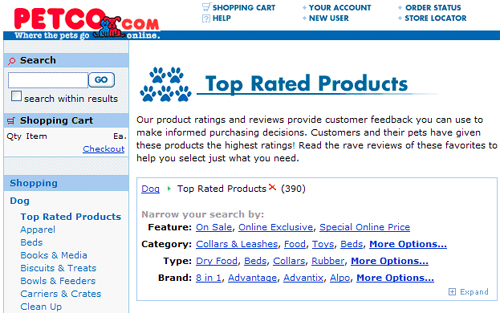
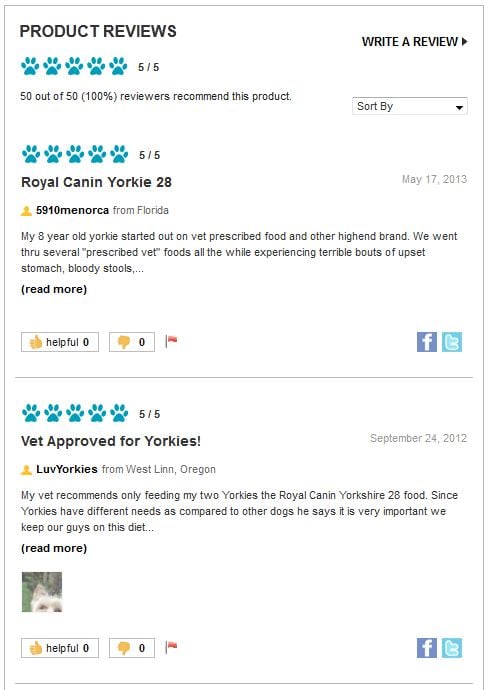
Who says that your customers can’t write your content for you? Having your customers add content to your blog is a great way to increase engagement. You can also include forums that will help build a community around your brand.
The fresh content that users generate will show up on search engine sites and increase your website’s ranking. In addition, your blog or forum will be full of relevant and useful information for other customers to read. Forums are a bit more self-perpetuating than blogs will be, but either way, users will enjoy the opportunity to voice their opinions and showcase their expertise on your site. You will also be able to access the collective knowledge of your customers and showcase it under your company name.
By leveraging the power of user-generated content on blogs and forums, you can turn new customers into repeat visitors and eventually, loyal customers.
If there are no guidelines or monitors, guest bloggers and forum users can voice their opinions with whatever keywords and structures that they want. There is definitely maintenance involved in having blogs and forums, but ultimately, your site will benefit from more fresh and valuable content than you could create on your own. Of course, if the time it takes monitoring your users’ content is taking you more time than it would have to write the blog posts in the first place, you may want to rethink this strategy.
In order for a blog or forum strategy to work, you will need a strong user base, full of individuals who are willing to generate the content. With a proper monitoring system and clear communication of what you want, this strategy can greatly benefit any online store willing to implement it.
Your brand is built on what other people are saying about your products or services. Threadless, a Chicago T-shirt company, has one of the most powerful forum communities in the industry. The customers connect on this forum by scoring, voting, discussing and critiquing each others’ ideas. Small to medium sized businesses simply cannot ignore the needs of their customers, which in some cases may be the need for a niche community. Consider your company values and how you could build a forum around those values.
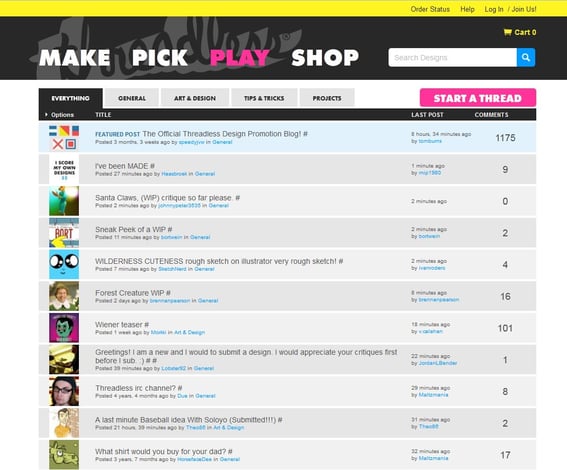
One of the most popular forms of UGC, picture sharing, is taking center stage for numerous ecommerce companies. If you sell something that customers can show themselves using or wearing, this may be the perfect strategy for your company. With the influx of photo and video sharing apps and websites, it’s no surprise that people will only remember 20% of what they read on your website. Images and videos are much more memorable.
Customer images are an especially valuable type of user generated content, especially when it involves customers sharing photos of how they are using or wearing your products. Giving customers a platform to showcase their photos will give you an opportunity to interact with them. Engagement for your brand will surely rise, and that engagement will likely turn into brand loyalty. By taking the extra step to link user photos to the product page they are associated with, you can drive additional traffic and revenue.
Social Proof is the desire to mimic and be like other people. The power of persuasion when it comes to conformity is the strength of implementing user photos into your ecommerce site. When a consumer sees an image of someone else using the product, it can give them that extra push that they needed to make their decision to purchase.
Get your customers excited about the opportunity. If you want to generate fan-photos, give them a chance to be featured on your product pages. Customers love generating content for brands, especially when it comes with some sort of personal recognition or incentive. Have a fun strategy and the content will surely follow. Generate a positive buzz around the promotion and watch the content pour in.
To protect your brand integrity, you will need to monitor user photos and videos. Make sure you have the resources and processes in order before you implement this strategy so that you can moderate in a timely manner. While professional photos may look nicer and be of better quality, the engagement and community that they create may be lacking. This is why using your customers’ photos can be extremely beneficial. They are already out there, you just need to find them. Search a #hashtag with your product title, and you’ll see how great the opportunity is for your business.
UGC in itself already acknowledges the fact that your customers have great ideas, ideas that can help you. Why not ask them what they think about your product? Maybe they even have ideas that could make your online store take off to places you couldn’t have even imagined.
User Generated Content can yield incredible creativity if you let it. Consider hosting a design contest for your next product. Let fans produce the next big thing for your company. After all, no one defines your brand as much as your customers do.
Many owners are afraid of letting go of control. Indeed, this is a risk, but it is one that has taken fan engagement to the next level for many, many companies.
Squishable uses social media to ask their customers for ideas on their products. From drawings to production the customers are the ones who are the thinkers behind the products.
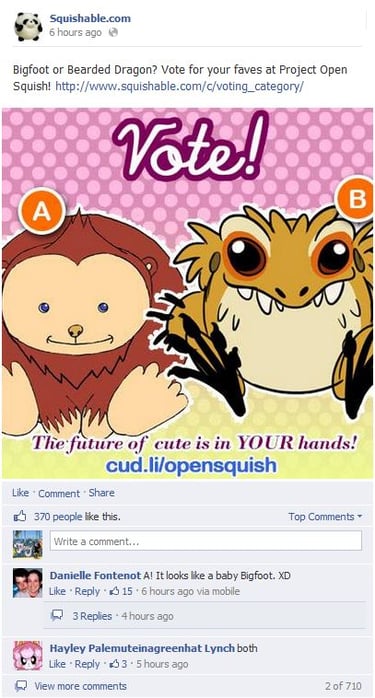
Threadless encourages customers who own the products to post their pictures on instagram or twitter. Customers can also just upload their pictures directly onto the product page.
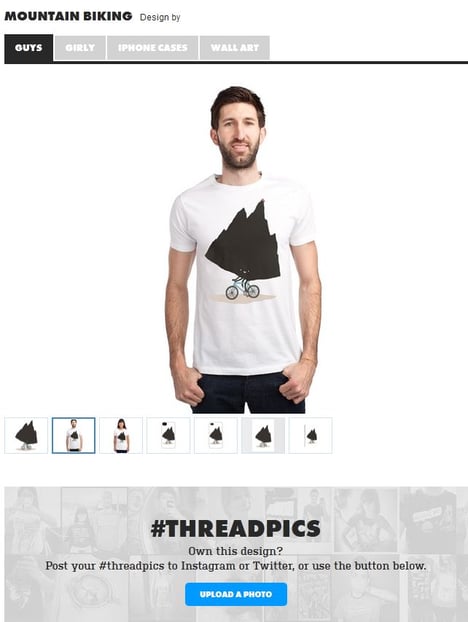
User Generate Content strategies, if implemented correctly, can significantly increase brand engagement and generate loyal customers. There are so many opportunities with the rise of social media and sharing platforms for your ecommerce store to find ways to generate the content that is so highly demanded in today’s world. It’s a win-win-win situation! You will get the content that your ecommerce store is in need of, your content-creators will get to share what they want with the world, and your content-viewers will be exposed to new and unique content!
If you are thinking of adding User Generated Content to your ecommerce store, go to PART 2: Reduce the Risks of User Generated Content, which will go over precautions you must take before implementing a User Generated Content strategy. In Part 3: Plan Your UGC Campaign, we will show you the 5 golden rules for creating a User Generated Content campaign.
Back to topNo worries, download the PDF version now and enjoy your reading later...
Download PDF Miva
Miva
Miva offers a flexible and adaptable ecommerce platform that evolves with businesses and allows them to drive sales, maximize average order value, cut overhead costs, and increase revenue. Miva has been helping businesses realize their ecommerce potential for over 20 years and empowering retail, wholesale, and direct-to-consumer sellers across all industries to transform their business through ecommerce.
Visit Website